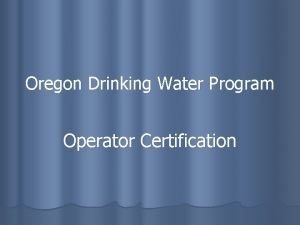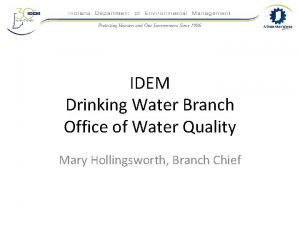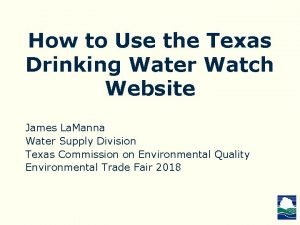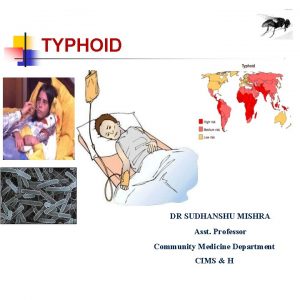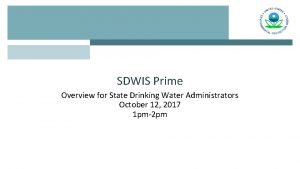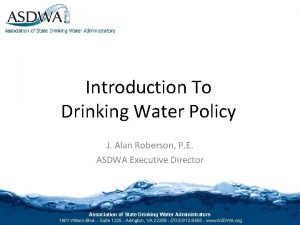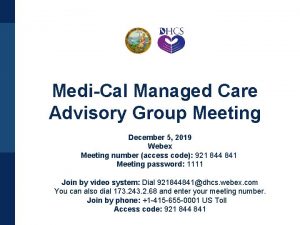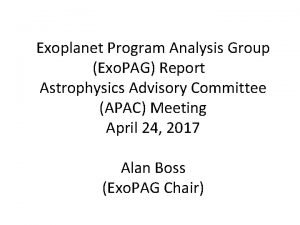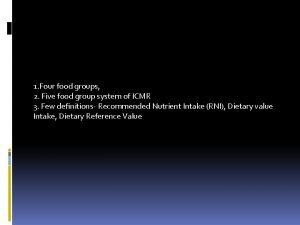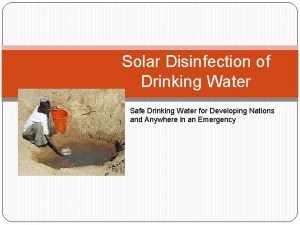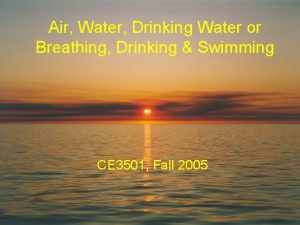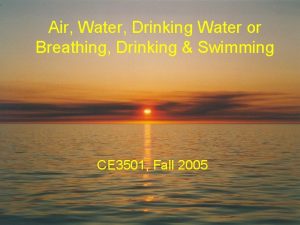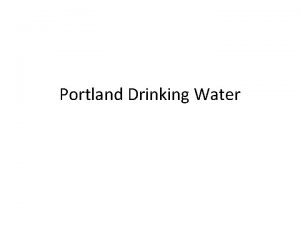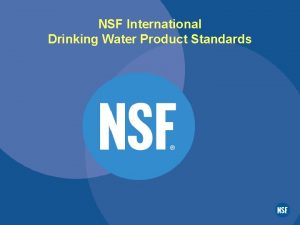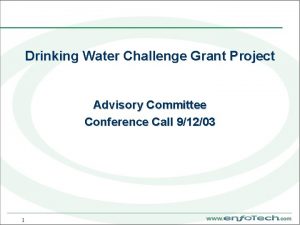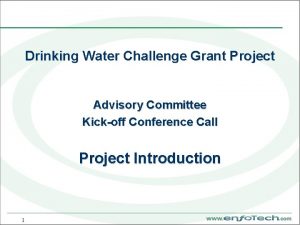Drinking Water Advisory Work Group Monitoring Plans Andrew























- Slides: 23

Drinking Water Advisory Work Group Monitoring Plans Andrew Nidoh July 16, 2019

Monitoring Plan Requirements • All monitoring conducted in accordance • • with Title 30, Texas Administrative Code (30 TAC), § 290 Subchapter F. Source and distribution details, including treatment. Plant schematic. Lab Approval Form. Other info such as PWS ID and effective or revision date. 2

Monitoring Plan Required For: • ALL public water systems (PWS) • If PWS treats surface water (including groundwater under its direct influence), submittal to the TCEQ upon development and revision is required. • Anytime an update occurs, the plan (or just the updated section if plan is current) will be resubmitted to TCEQ. • Outreach over the last year 3

Monitoring Plan Required For: • If PWS treats and/or distributes groundwater or purchased water, a copy of the monitoring plan shall be maintained at each plant and in a central location. • The plan is subject to review during Compliance Inspections and is not required to be submitted to TCEQ, unless requested. **These plans are actually utilized by the TCEQ on a frequent basis, especially during abnormal circumstances. 4

Monitoring Plan: Reminders • Entry point sampling applies to every • • system. All sections need to include a sample schedule, sample location(s), method or lab used for analysis, and applicable compliance statements. Include any and all plant schematics. Fill out Lab Approval Form for your PWS. Include attachments such as RTCR Sample Siting Plan and NAP. 5

Using Drinking Water Watch (DWW) • DWW Menu bar: Water system facilities Sample points & schedules Contact information 6

Using Drinking Water Watch (DWW) Water system facilities: Entry Points (EP) Source ID (G/S/P) Review and determine if the information is correct (i. e. active vs. inactive) 7

Using Drinking Water Watch (DWW) • Sample schedules: Req’s: how often sampling occurs, such as 1 RT/3 YR 1 sample every 3 years Analyte group: what will be sampled. 8

Inorganics, Organics and Radionuclide Rules Use Drinking Water Watch to list sample schedules for specific analytes and entry points. • Nitrate • Nitrite • Cyanide • SOC Methods 504, 515, 531 • MIN (or Secondaries group for transient systems) • MTL • VOC • SOC 5 • RAD 9

Plant Schematic All monitoring plans must include a schematic for any plant(s), which needs to include: • Chemical additions • Sampling locations • Physical components such as pumps • Water flow, including all sources • Entire water recycling process (if 10 applicable)

System Schematic • SW Schematic example: 11

System Schematic • GW Schematic example: 12

Revised Total Coliform Rule • Sample Siting Plan: • List total number of samples required • List address for all routine and possible repeat sample locations 13

Distribution Map: • New requirement under the Revised Total Coliform Rule and must contain: • All coliform routine locations • All storage units in use by the system • All active entry points • Distribution water mains and sizes • Pressure plane boundaries (if > 1) 14

Nitrification Action Plan • If the system has chloraminated water (the water has a total chlorine residual) at any point, a Nitrification Action Plan (NAP) needs to be developed and attached to the system’s overall monitoring plan. • NAP template can be found online to aid water systems in controlling nitrification within their distribution system. 15

Lab Approval Form All systems that use on-site methods to analyze: • Free and total chlorine disinfectant residual • Turbidity and total organic carbon • p. H • Temperature • Alkalinity • Chlorine dioxide and daily EP chlorite • Calcium • Phosphate • Ultraviolet light absorbance at 254 nm (UV 254) 16

Required Attachment: Lab Approval Form • Must use analysis methods approved by the EPA and the TCEQ. • Forms will be reviewed once received by central office and approved accordingly. • Form available through RG-384 • New form available via request to PDWS@tceq. texas. gov or the Lab Approval Form Coordinator at (512)239 -4691 17

What resources are available to help? • Monitoring Plan Coordinator: (512)239 -4691 • Email boxes: PWSINVEN@tceq. texas. gov PWSCHEM@tceq. texas. gov PWSLCR@tceq. texas. gov DBP@tceq. texas. gov FMT@tceq. texas. gov 18

Questions Andrew Nidoh Andrew. Nidoh@tceq. texas. gov (512)239 -4611

Drinking Water Advisory Work Group Sample Siting Plans Lillian Johnson July 16, 2019

RTCR Sample Siting Plan (SSP) • SSPs are an attachment to the Monitoring Plan • Find the template on the TCEQ RTCR webpage • If you haven’t submitted an SSP – do it ASAP! • Email SSPs to TCRdata@tceq. texas. gov

RTCR Sample Siting Plan Cont. • Keep this document current • Revise as necessary • SSP form is self explanatory but please call if you have questions! • 512 -239 -5283 – Lillian Johnson

SSP Site Locations • List all routine sampling locations plus additional alternate locations • List multiple repeat sampling locations – 5 upstream & 5 downstream • List more locations than are required to prepare for changes
 Water and water and water water
Water and water and water water Dww tceq
Dww tceq Drinking water state revolving fund
Drinking water state revolving fund Oregon drinking water certification
Oregon drinking water certification Drinking water watch indiana
Drinking water watch indiana Tceq drinking water watch
Tceq drinking water watch Lithium in drinking water
Lithium in drinking water Drinking water
Drinking water Drinking water system operator certificate
Drinking water system operator certificate Prime drinking water
Prime drinking water Nm drinking water watch
Nm drinking water watch Jms advisory group
Jms advisory group Eprat get
Eprat get Xx2021x
Xx2021x Advisory expert group on national accounts
Advisory expert group on national accounts Exo advisory group
Exo advisory group Nato niag
Nato niag Defense trade advisory group
Defense trade advisory group Social goal model example
Social goal model example A group vs a team
A group vs a team Smart work vs hard work group discussion
Smart work vs hard work group discussion Food group plans
Food group plans The five food groups
The five food groups A long walk to water final project ideas
A long walk to water final project ideas



